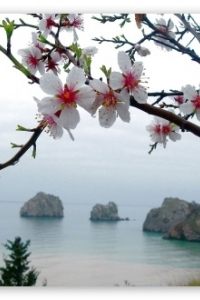
I still remember the annual exam holidays, when we chased grasshoppers in the vacant plot that stretched before our house. Even the minimum showers during the summer blessed the land with thick, bushy plants.
Short, bushy, thumbai plants with their white flowers and the nerunji plants that crept along the ground with their bright yellow flowers were really a treat to see.
The nerunji plants had dry, thorny fruits that at times could prick your feet and made you wince in pain. If you pulled the broken thorn from the thick skin of your bare feet, little drops of blood would ooze out.
Whenever the thorn pricked my feet, I plucked a few leaves of the thumbai plant, crushed it and patted it on the wound on my bare feet, and within seconds I felt relieved. The fresh herbal juice of the thumbai leaves was cold on the skin and it immediately gave a soothing effect.
Sometimes we plucked the white thumbai flowers and made garlands out of it. The small chakras made out of thumbai flowers resembled my favoruite snack, murukku, which is made with rice and urad dal.
While collecting the thumbai flowers, it was a feast to watch colourful butterflies that flew around the thumbai plants to suck the nectar from the flowers. It was wonderful to watch the butterflies stretching their proboscis and drinking the nectar. Most of the butterflies had black wings with red eye-like structures painted in the middle.
Apart from butterflies, numerous grasshoppers hopped around. There were grasshoppers of all sizes, from tiny to big. Green-coloured grasshoppers, brown-coloured grasshoppers and pale grey-coloured grasshoppers.
It took a while for me to learn how to catch the grasshoppers. They kept on hopping and jumping from one place to another.
We caught the green-coloured grasshoppers and filled our glass bottles with many of them. After keeping them inside the bottle for some time, we would release them.
One day we caught many grasshoppers and wanted to feed them to our chickens. We wanted to do something different that day. We gathered dry twigs and leaves that were scattered below the trees. One of us took a sheet cut from an empty talcum powder tin.
We all then built an oven with the broken bricks and stones. After filling the oven with dry twigs and leaves, we placed the sheet of tin on the oven.
With the match stick we lit the dry leaves and twigs and made a fire. When the sheet got hot, we placed the wax collected from burnt candles.
The wax started to melt and it looked like oil. One by one we took the grasshoppers out of the bottle. We removed the legs and the head of the grasshoppers. We didn’t even realise how painful it would be for those tiny creatures.
We then roasted the headless, legless grasshoppers in the melting wax. After roasting the grasshoppers for a while, we took them out from the fire.
We placed the roasted grasshoppers on a paper and called the chickens to taste the toast. The chickens came running and ate the grasshoppers within seconds. We all clapped our hands and laughed loudly.
The memory of chasing and roasting grasshoppers is still fresh in my mind. The difference is now I feel I don’t have the right to kill the grasshoppers like this and how they would have cursed me for taking their lives.
Every living thing in the world has the right to live their lives. Is it childhood frenzy that made me do that? Why should I kill those innocent grasshoppers and feed them to the chickens? Does it reflect the cruel nature that is hidden deeper within me?
When I narrated this to Priyanka, one of my younger colleagues, she passed on a remark, “That is too bad. How dare you do that?” I apologised to her. She shared with me an incident during her school days.
During rainy seasons, grasshoppers from the school garden would come inside their class through the windows. Whoever caught the grasshopper was considered lucky, as they were considered to bring prosperity and wealth.
I felt ashamed and could not face her directly for a few minutes.
About the Author







Comments